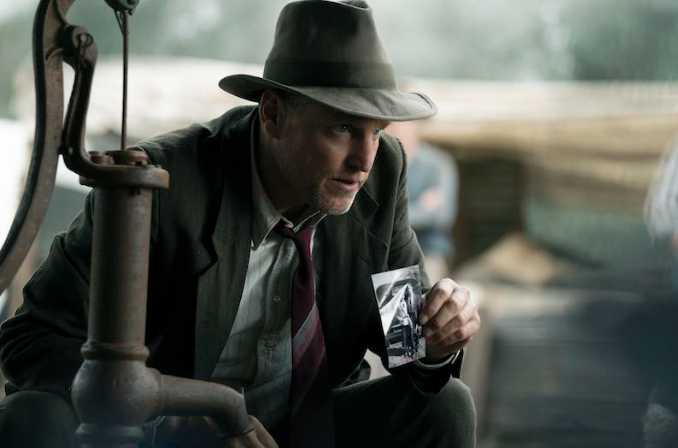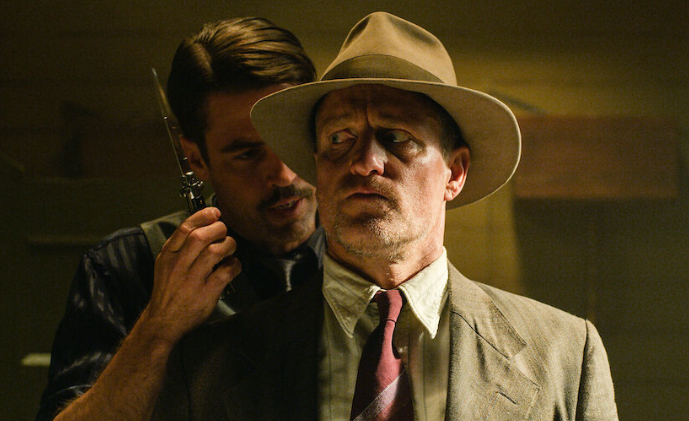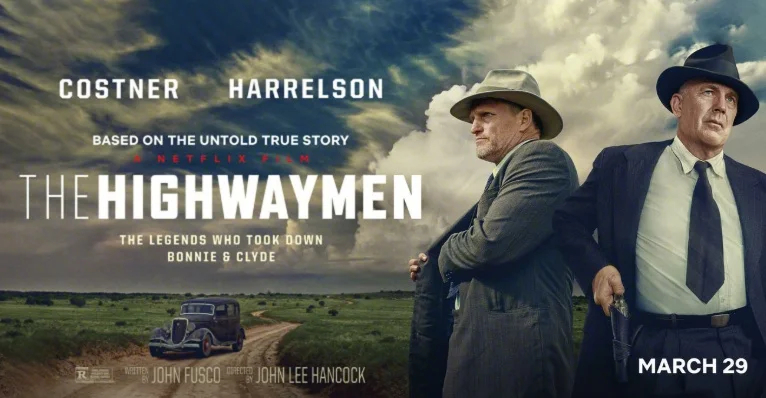The Highwaymen (2019)
The outlaws made headlines. The lawmen made history.
🔫 Plot Overview
The Highwaymen revisits the myth of Bonnie and Clyde—not through the glamorized lens of rebellion, but from the weary eyes of the men who hunted them. Set in 1934 America, as the country recovers from the Great Depression and organized crime captures the public imagination, the film centers on two aging Texas Rangers: Frank Hamer (Kevin Costner) and Maney Gault (Woody Harrelson). Reinstated from retirement, they’re tasked with stopping the outlaw couple who’ve become folk heroes, leaving blood and chaos in their wake.
What unfolds isn’t a cat-and-mouse thriller, but a patient, reflective manhunt—a slow burn that favors character over spectacle, morality over myth.
🎭 Characters & Performances
Kevin Costner embodies Frank Hamer with a stoic rigidity that feels worn but unbreakable. He’s a man haunted by past violence and unsure of his place in a world that celebrates criminals. Woody Harrelson’s Maney Gault, by contrast, brings humor and soul, portraying a man broken by time and guilt, trying to find peace in the only way he knows: by doing what he was trained for.
Their chemistry is quiet but magnetic—two relics of a vanishing era, stitched together by duty, regret, and shared history. The film doesn’t glorify them, nor does it vilify the outlaws—it lets the moral grayness settle like Texas dust.
🎥 Direction & Visuals
Director John Lee Hancock (The Blind Side, Saving Mr. Banks) opts for restraint over dramatics. The cinematography—shot in muted earth tones—captures the vastness of the American South as a land both beautiful and barren, mirroring the desolation in its characters. Long drives, empty roads, and slow camera pans emphasize isolation, lawlessness, and a nation in moral limbo.

Every choice—from the sparse score to the minimalist editing—feels intentional, reinforcing the story’s underlying tragedy: this isn’t about heroes catching villains. It’s about men doing what no one else could, even if no one wanted to see it done.
💭 Themes & Meaning
The Highwaymen flips the American outlaw myth on its head. While Bonnie and Clyde are rarely shown up close, their presence looms like a cultural fog. They are symbols—romanticized by the public, commodified by the press, and feared by the very people tasked with stopping them.
This is a story about justice vs. fame, the burden of responsibility, and the loneliness of doing the right thing when it’s no longer fashionable. It asks: what happens to men like Hamer and Gault when the world no longer needs their kind of justice? And worse—what if it never truly did?

✅ Strengths
- Stellar performances by Costner and Harrelson, portraying aged men with gravity and dignity
- Elegant cinematography capturing the harsh beauty of 1930s Texas
- A sobering, revisionist take on a well-worn American legend
- Strong pacing that rewards patience and emotional investment
❌ Weaknesses
- Slow pace may test viewers expecting action or classic crime thrills
- Minimal female presence and limited exploration of Bonnie and Clyde themselves
- Lack of dramatic confrontations, opting instead for restraint and realism
🌟 Final Verdict
Rating: ★★★★☆ (4/5)
The Highwaymen is a quiet powerhouse—a film that strips away the glamor of American outlaw mythology to show the toll on the men who cleaned up the mess. It’s about aging, purpose, and the price of moral clarity in a world too enamored with chaos. Deeply rooted in realism, its power lies not in shootouts, but in silence—in long drives, heavy looks, and the weight of a loaded past.

It’s not about how Bonnie and Clyde died. It’s about what it took to end the myth.
